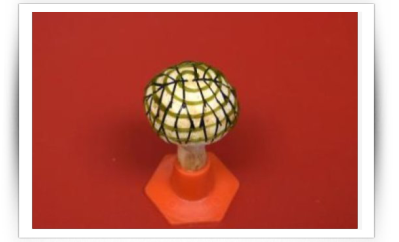| In their latest feat of engineering, researchers at Stevens Institute of Technology have taken an ordinary white button mushroom from a grocery store and made it bionic, supercharging it with 3D-printed clusters of cyano bacteria that generate electricity and swirls of graphene nanoribbons that can collect the current.
"In this case, our system -- this bionic mushroom -- produces electricity," said Manu Mannoor, an assistant professor of mechanical engineering at Stevens. "By integrating cyano bacteria that can produce electricity, with nanoscale materials capable of collecting the current, we were able to better access the unique properties of both, augment them, and create an entirely new functional bionic system."
Cyano bacteria's ability to produce electricity is well known in bioengineering circles. However, researchers have been limited in using these microbes in bioengineered systems because cyano bacteria do not survive long on artificial bio-compatible surfaces. Mannoor and Sudeep Joshi, a postdoctoral fellow in his lab, wondered if white button mushrooms, which naturally host a rich microbiota but not cyano bacteria specifically, could provide the right environment -- nutrients, moisture, pH and temperature -- for the cyano bacteria to produce electricity for a longer period.
Mannoor and Joshi showed that the cyano bacterial cells lasted several days longer when placed on the cap of a white button mushroom versus a silicone and dead mushroom as suitable controls. "The mushrooms essentially serve as a suitable environmental substrate with advanced functionality of nourishing the energy producing cyano bacteria," says Joshi.
|
Mannoor and Joshi used a robotic arm-based 3D printer to first print an "electronic ink" containing the graphene nanoribbons.
This printed branched network serves as an electricity-collecting network atop the mushroom's cap by acting like a nano-probe -- to access bio-electrons generated inside the cyano bacterial cells.
Next, they printed “bio-ink” containing cyano bacteria onto the mushroom's cap in a spiral pattern intersecting with the electronic ink at multiple contact points. At these locations, electrons could transfer through the outer membranes of the cyano bacteria to the conductive network of graphene nanoribbons. Shining a light on the mushrooms activated cyano bacterial photosynthesis, generating a photocurrent.
*Source: https://www.sciencedaily.com/releases/2018/11/181107082454.htm
 *Image source: https://www.sciencedaily.com/releases/2018/11/181107082454.htm
*Image source: https://www.sciencedaily.com/releases/2018/11/181107082454.htm |